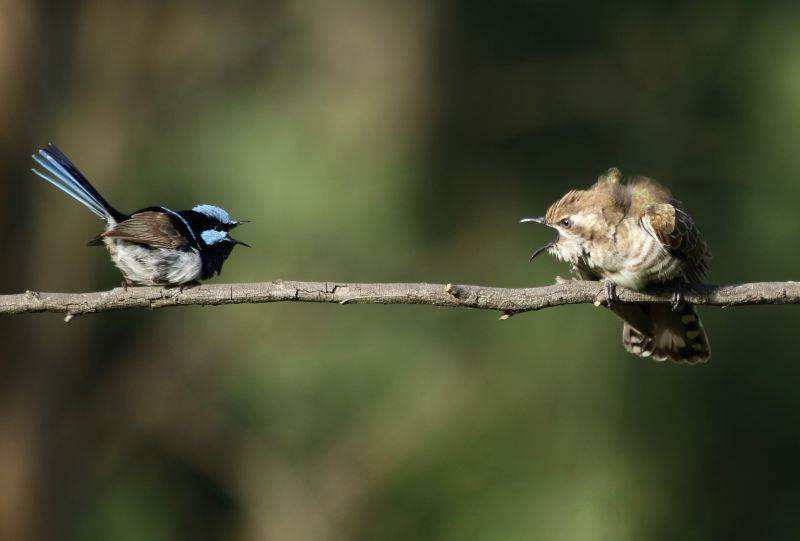Scientists discover first animal vocalization that combines instinct and learning

A male superb fairy-wren (Malurus cyaneus) confronting a Horsfield’s bronze cuckoo (Chalcites basalis). Credit: David Ongley
An international study led by the Doñana Biological Station (EBD-CSIC) provides the first known example of an animal vocalization that is learned from an innate response shared across multiple species. The discovery, published in Nature Ecology and Evolution, involves the identifying of a similar vocalisation in more than twenty species around the world. The results provide a glimpse into the role natural selection can play in the evolution of vocal communication and challenges the traditional division between animal communication and human language.
“For the first time, we have documented a vocalization that has both learned and innate components, potentially showing how learned signals may have evolved from innate calls in a way first suggested by Charles Darwin,” explains William Feeney, evolutionary ecologist at the Doñana Biological Station and lead author of the study. “It’s like seeing how evolution can enable species to give learned meanings to sounds.”
The researchers found that more than 20 different bird species across four continents produce nearly identical “whining” vocalizations when they spot a parasitic bird, such as cuckoos, in their territory. These species lay their eggs in other species’ nests, forcing the host to raise their young, often at the expense of the host’s own offspring. Identifying and deterring these parasites therefore provides a clear evolutionary advantage.
Why birds from locations spanning Australia, China and Zambia all use the same call to identify their parasites, despite never coming into contact with each other? To answer this, the researchers used playback experiments to assess how hosts responded to whining calls compared to other vocalizations and used model presentation experiments to assess how individuals responded to seeing a cuckoo compared to seeing predators and nonpredators.
Between instinct and learning
Results showed that when a bird hears the warning call, it instinctively comes to investigate. At that moment, the birds began to absorbe the clues around them and learned to associate the sound with the presence of a parasite. “This is what is known as social transmission,” said Damián Blasi, co-author of the study and language scientist at Pompeu Fabra University, Spain.
This ability to observe and learn from the environment does not only produce an immediate reaction; it also influences the birds’ future behavior. “It is at that moment that birds learn when to produce this sound in the future,” said James Kennerley, co-lead author and postdoctoral researcher at the Cornell Lab of Ornithology.
Beyond the learning mechanism, the discovery has broader evolutionary implications and offers new perspectives on the origins of learned language. “The fascinating thing about this call is that it represents a midpoint between the instinctive vocalizations we often see in animals and fully learned vocal units like human words,” said Feeney.
The research also revealed that species producing this type of call tend to live in areas with complex networks, where interactions between brood parasites and their hosts are frequent. “With birds working together to drive away parasites, communicating how and when to cooperate is really important, so this call appears in parts of the world where species are most affected by brood parasitism,” explains Kennerley. The result, he adds, “is that the evolution of the whining vocalization is affecting patterns of cooperative behavior between bird around the world.”
The link between the innate whining sound and the learned response by the bird is what makes this study unique, the authors said. The findings challenge long-held assumptions about the sharp division between animal communication systems and human language. The authors suggest that learned communication systems, like human language, may have evolved through the gradual integration of instinctive and learned elements.
This work was supported by the Alexander von Humboldt Foundation, Birds Queensland, the British Trust for Ornithology, the Hermon-Slade Foundation, an Edward W. Rose Postdoctoral Fellowship in the Cornell Lab of Ornithology, and the U.S. National Science Foundation.
Research group website: http://originsandadaptations.com/
Reference
William E. Feeney, James A. Kennerley, David Wheatcroft, Wei Liang, Joleah B. Lamb, Niki Teunissen, Shelby L. Lawson, Janice K. Enos, Bo Zhou, Colleen Poje, Nicole M. Richardson, Thomas A. Ryan, Zara-Louise Cowan, Rohan M. Brooker, Mairenn Attwood, Jordan Boersma, Marissa Zamora, Alfredo Attisano, Roman Gula, Jörn Theuerkauf, Ros Gloag, Vanina D. Fiorini, Sharon A. Gill, Anne Peters, Marcel Honza, Claire N. Spottiswoode, Mark E. Hauber, Andrea Manica, Michael S. Webster & Damián E. Blasi. Learned use of an innate sound-meaning association in birds. Nature Ecology and Evolution. https://www.nature.com/articles/s41559-025-02855-9